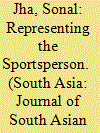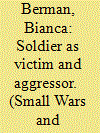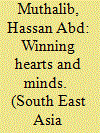| Srl | Item |
| 1 |
ID:
168805


|
|
|
|
|
| Summary/Abstract |
This paper follows a call for a new direction for sports studies in India, orienting it towards the field of cultural studies. It focuses on the representation of the figure of the sports celebrity in television advertising in India from the 1980s to the present, establishing the various kinds of representations of this figure, and proceeds to a historical analysis of the changes that these representations have undergone over time. It also argues that the evolution of the celebrity sportsperson, and the meanings attached to this figure, can help in tracing larger changes in sports discourse in India.
|
|
|
|
|
|
|
|
|
|
|
|
|
|
|
|
| 2 |
ID:
190719


|
|
|
|
|
| Summary/Abstract |
This article examines the subversion of the hero soldier figure in three Vietnam War films from three different nations that faced defeat in Vietnam: Coppola’s Apocalypse Now, Schoendoerffer’s Dien Bien Phu, and Jeong Ji-yeong’s White Badge. A close analysis reveals that all three films undermine the image of the virtuous and powerful hero soldier through recurring stylistic elements. Apocalypse Now, through the ‘Ride of the Valkyries’ helicopter sequence – as well as the opening and ending sequences – portrays the American soldier as a barbaric aggressor. Dien Bien Phu, meanwhile, visually undermines the image of the powerful hero soldier through cinematographic techniques which portray the French soldiers in the field as small and powerless. Finally, White Badge – which, unlike the two other films, takes place in the post-war period – subverts the image of the hero soldier through its use of auditory and visual elements to portray the Korean soldier as aggressor and, first and foremost, victim. The article concludes with a discussion of how the three films influence audiences’ perceptions of those who fought in Vietnam.
|
|
|
|
|
|
|
|
|
|
|
|
|
|
|
|
| 3 |
ID:
086847


|
|
|
|
|
| Publication |
2009.
|
| Summary/Abstract |
A comparison of Malay films produced in the 1950s in the Chinese-owned, Singapore-based Malay film industry with those produced in the Kuala Lumpur-based, government-supported Malayan Film Unit (MFU) exposes many similarities in how Malays were represented on film in the lead-up to Malayan independence in 1957. While the social realist films produced in Singapore urged ordinary Malays to accept changes that were occurring in society and the films produced by the MFU reinforced government propaganda and helped develop new heroes for the nation, both traditions portrayed Malays as being very comfortable and prosperous in an idyllic rural environment.
|
|
|
|
|
|
|
|
|
|
|
|
|
|
|
|